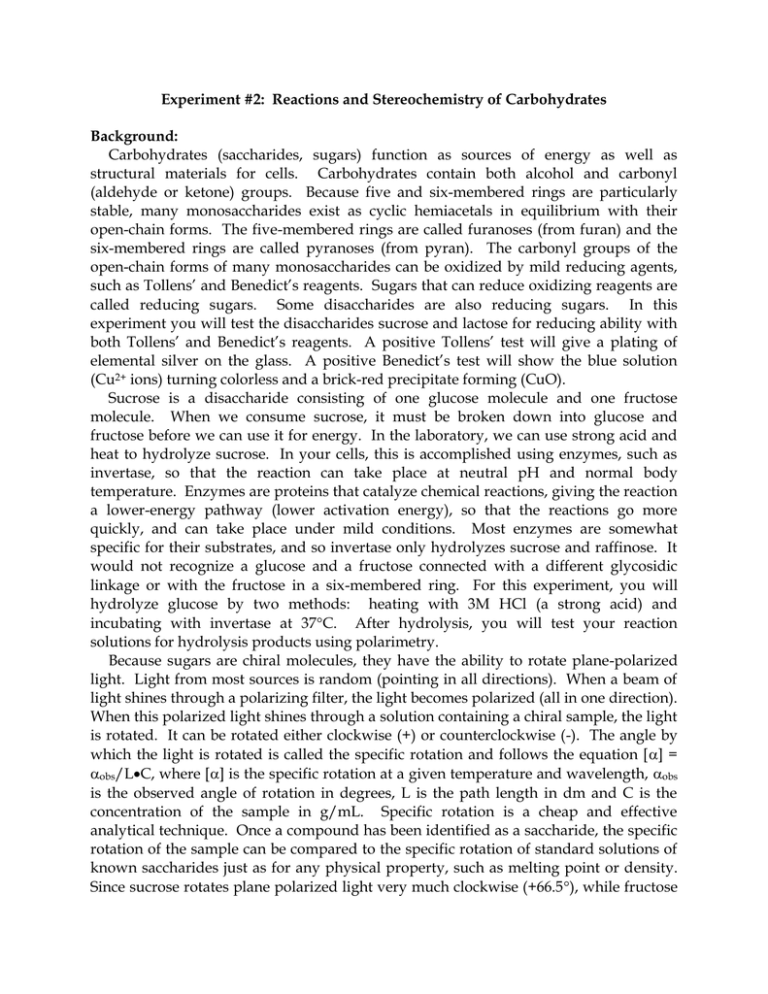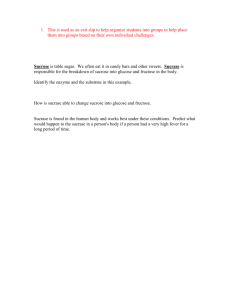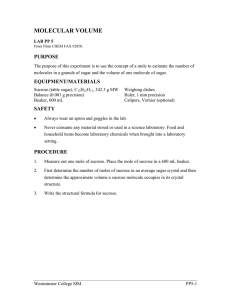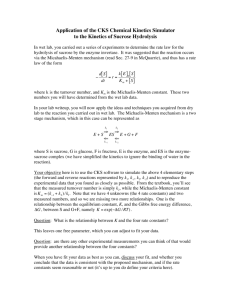Experiment #2: Reactions and Stereochemistry of Carbohydrates Background:
advertisement

Experiment #2: Reactions and Stereochemistry of Carbohydrates Background: Carbohydrates (saccharides, sugars) function as sources of energy as well as structural materials for cells. Carbohydrates contain both alcohol and carbonyl (aldehyde or ketone) groups. Because five and six-membered rings are particularly stable, many monosaccharides exist as cyclic hemiacetals in equilibrium with their open-chain forms. The five-membered rings are called furanoses (from furan) and the six-membered rings are called pyranoses (from pyran). The carbonyl groups of the open-chain forms of many monosaccharides can be oxidized by mild reducing agents, such as Tollens’ and Benedict’s reagents. Sugars that can reduce oxidizing reagents are called reducing sugars. Some disaccharides are also reducing sugars. In this experiment you will test the disaccharides sucrose and lactose for reducing ability with both Tollens’ and Benedict’s reagents. A positive Tollens’ test will give a plating of elemental silver on the glass. A positive Benedict’s test will show the blue solution (Cu2+ ions) turning colorless and a brick-red precipitate forming (CuO). Sucrose is a disaccharide consisting of one glucose molecule and one fructose molecule. When we consume sucrose, it must be broken down into glucose and fructose before we can use it for energy. In the laboratory, we can use strong acid and heat to hydrolyze sucrose. In your cells, this is accomplished using enzymes, such as invertase, so that the reaction can take place at neutral pH and normal body temperature. Enzymes are proteins that catalyze chemical reactions, giving the reaction a lower-energy pathway (lower activation energy), so that the reactions go more quickly, and can take place under mild conditions. Most enzymes are somewhat specific for their substrates, and so invertase only hydrolyzes sucrose and raffinose. It would not recognize a glucose and a fructose connected with a different glycosidic linkage or with the fructose in a six-membered ring. For this experiment, you will hydrolyze glucose by two methods: heating with 3M HCl (a strong acid) and incubating with invertase at 37C. After hydrolysis, you will test your reaction solutions for hydrolysis products using polarimetry. Because sugars are chiral molecules, they have the ability to rotate plane-polarized light. Light from most sources is random (pointing in all directions). When a beam of light shines through a polarizing filter, the light becomes polarized (all in one direction). When this polarized light shines through a solution containing a chiral sample, the light is rotated. It can be rotated either clockwise (+) or counterclockwise (-). The angle by which the light is rotated is called the specific rotation and follows the equation [] = obs/LC, where [] is the specific rotation at a given temperature and wavelength, obs is the observed angle of rotation in degrees, L is the path length in dm and C is the concentration of the sample in g/mL. Specific rotation is a cheap and effective analytical technique. Once a compound has been identified as a saccharide, the specific rotation of the sample can be compared to the specific rotation of standard solutions of known saccharides just as for any physical property, such as melting point or density. Since sucrose rotates plane polarized light very much clockwise (+66.5), while fructose rotates it very much counterclockwise (-92.0), polarimetry can be used to moniter the hydrolysis of sucrose. Although glucose rotates the light clockwise (+52.0), a one-toone mixture of glucose and fructose will still produce a significant counterclockwise rotation (about -40). For this experiment, after your hydrolysis reactions are complete, you will test for the presence of fructose (a hydrolysis product) using polarimetry by looking for a strong negative rotation. Materials: Sucrose, lactose, 5% silver nitrate solution, 2% ammonium nitrate solution, 5% sodium hydroxide solution, Benedict’s reagent, 3 M HCl solution, invertase, distilled water, nine test tubes (7 large, 2 small) Procedures: 1. Add 0.50 g of sucrose to three different large test tubes, and albel them #1, #2 and #3. 2. Add 10 mL of distilled water to tube 1 (this is a blank, or control, tube). Add 10 mL of 3 M HCl to tube 2. Add 10 mL of distilled water and 2 mg of invertase to tube 3. Mix each solution thoroughly. 3. Place the three test tubes in a 37C water bath for 50 minutes. Shake test tube 3 periodically. 4. While you are waiting for the three solutions to incubate, you will test sucrose and lactose for reducing ability. Label a large test tube as #4 and add 0.4 g of sucrose and 7 mL of distilled water. Label a large test tube as #5 and add 0.4 g of lactose and 7 mL of distilled water. Mix both solutions thoroughly. 5. Perform the Tollens’ and Benedict’s tests on the solutions in tubes 4 and 5 (tests described below). Record your observations for these tests, including whether the result is positive or negative, in a table. Tollens’ test: to an empty small test tube, add 10 drops of 5% silver nitrate solution and 2 drops of 5% sodium hydroxide. Add enough 2% ammonium nitrate to just dissolve the black precipitate (shake the tube to mix). Be sure not to add an excess of ammonium hydroxide. Once the solution is clear, add 4 drops of your sugar solution. Formation of a silver mirror on the interior of the test tube is a positive test for a reducing sugar. Note: gentle heating in the 37C water bath will facilitate the reaction. Benedict’s test: to an empty large test tube, add 2 mL of your sugar solution and 5 mL of Benedict’s reagent. Heat in the 37C water bath for 10 minutes. A reducing sugar will produce a red, green or yellow precipitate. 6. Take polarimetry readings for tubes 1, 2 and 3 after the 50-minute incubation period is done. The instructor will show you how to use the polarimeter. A negative rotation value indicates the presence of fructose and glucose. A positive rotation value indicates the presence of sucrose. Note: you may need to filter the solution in tube 3 before you take a polarimeter reading since a cloudy solution can affect the reading. Pre-Lab: 1. Prepare your notebook as described in the lab notebook handout. Include: name, title of experiment, date, purpose, procedures (bulleted list) and tables for data and observations. 2. Answer the following pre-lab questions: a) Write the Haworth structures for sucrose and lactose. b) Do you expect sucrose and/or lactose to a be reducing sugar? Explain. c) If you predict that one (or both) of the sugars will be a reducing sugar, write the chemical reaction (show structures) for each reducing sugar with Tollens’ reagent (you can just write “Tollens” for the reagents). d) Write the reaction (show structures) for the hydrolysis of sucrose. Report: 1. In your notebook, write a brief discussion of the experiment. In this section you should summarize your results (were the sugars reducing? did the sucrose get hydrolyzed by both methods? What did the polarimetry data indicate?), note any interesting observations and make any possible conclusions about the experiment (successful vs. unsuccessful and reasons why). Be sure to compare your results to the expected/desired results (did you get the results that you expected/predicted?). Try to explain your results based on the chemistry (for example: what structural features make a reducing sugar?). 2. Answer the post-lab questions: a) Fructose does not always form a five-membered ring. In fact, only about 20% of the fructose hemiacetals in solution will be in the furanose form, while about 80% will be in the pyranose (six-membered ring) form. Draw the structure of -D-fructose in its pyranose form. b) When hydrolysis of sucrose is carried out with invertase, the optical rotation keeps slowly changing to become more negative, even after the enzyme is deactivated. This does not happen when the hydrolysis is carried out with aqueous HCl. Explain. 3. Photocopy (or carbon copy) your notebook pages, attach questions (if not in notebook) and turn it in.



